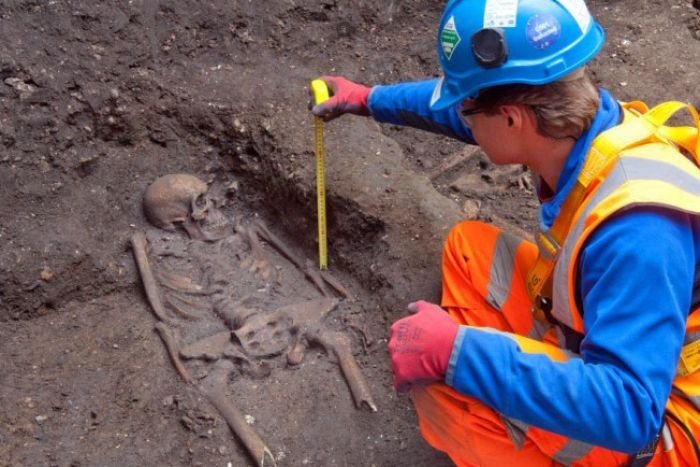London Rail Workers Unearth Plague Victims in Medieval Burial Pit

Archaeologists have been called in after workers on the London Crossrail project stumbled over a medieval burial pit for victims of the Black Death.
Work on the $15 billion project was delayed after engineers unearthed 14 bodies at a previously unidentified burial ground in Farringdon, east London.
Twelve skeletons were discovered over the past fortnight, buried in neat rows, with two more found on Friday 15 March.
Around 1.5 million Britons are believed to have died from the bubonic plague, which reached epidemic proportions from around the year 1348. Seventy-five million people are thought to have died worldwide.
Historical documents such as John Stow's 1598 Survey of London suggest the area surrounding Charterhouse Square, where the bodies were found, could contain up to 50,000 bodies, with another 100,000 thought to be interred elsewhere across the capital.
Archaeologists from the Museum of London are now conducting forensic tests on the skeletons, including radio carbon dating, to establish the burial dates and map the bacteria's DNA.
The research could provide insight into the cause of the epidemics that swept London for over 300 years.
"It is a fascinating discovery," said Professor Justin Champion of Royal Holloway University. "In some of the poorest areas outside the city walls, such as Southwark and Clerkenwell, people would just drop dead in the street.
"With a lot of London churches you can see the churchyard is above street level. That is because of the number of bodies underneath. During the epidemics they would have been overwhelmed.
"They would go from dealing with a handful of deaths to over 100 a week. My guess is a lot of the graves are still there. If you looked, particularly under some of the old buildings, you would find an awful lot more."
The disease was eventually traced to the digestive tract of fleas, which were carried by the rats infesting the city's streets.
Even today, a handful of Britons are infected with the plague each year, while in the US, a girl of seven was diagnosed with the condition last September.
However, archaeologists insisted there were no health risks associated with the findings.
"It is a great myth that we will disturb some evil grave in London and this disease will come out and kill us all," said Prof Champion.
"That is just not going to happen."
© Copyright IBTimes 2025. All rights reserved.



















